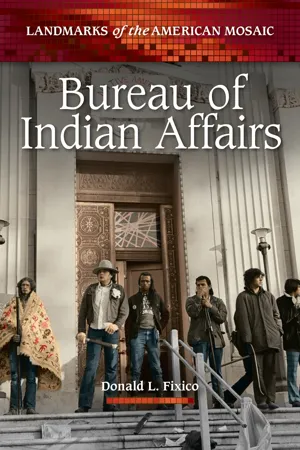History
Dennis Banks
Dennis Banks was a Native American activist and co-founder of the American Indian Movement (AIM) in 1968. He was a leading figure in the movement for Native American rights and worked to raise awareness of the injustices faced by Indigenous peoples in the United States. Banks passed away in 2017 at the age of 80.
Written by Perlego with AI-assistance
Related key terms
3 Key excerpts on "Dennis Banks"
- eBook - ePub
- Immanuel Ness(Author)
- 2015(Publication Date)
- Routledge(Publisher)
The Last of the Mohicans in 1992.James G. LewisPaul area. Dennis Banks was therefore openly recruiting from the moment he first visited the island in December 1969. His major coup in this respect was his success in bringing into the fold IAT's oratorically gifted spokesperson, a young Santee named John Trudell (now an acclaimed poet) who went on to fulfill the same function for AIM from 1970 to 1979. Also signed up was Russell Means, a reservation-born but urban-raised Oglala Lakota imbued with what many saw as a strong ability to garner the attention of the media. It was Means who conceived of and led the Mount Rushmore occupation during the fall of 1970, as well as a sequel carried out the following June. It was Means, too, who organized AIM's seizure of the Mayflower replica anchored at Plymouth, Massachusetts, on Thanksgiving Day, 1971; the ship itself was briefly used as a podium from which a list of Indian grievances was delivered, while Plymouth Rock was painted red.Simultaneously, other AIM members were busily engineering a series of confrontations and Alcatraz-style occupations designed to attain more concrete goals. The 1971 takeover of unused military facilities at Fort Lawton, near Seattle, for instance, ultimately resulted in the construction, on the site, of an American Indian cultural center. Confrontations in Oklahoma and Minnesota precipitated Indian control over schools in both states. Another confrontation in Denver led to improved healthcare for native people in that city. Under these circumstances, AIM chapters began to sprout up all over North America; by late 1972, the unofficial count was forty-three in the United States and another half-dozen in Canada; a year after that, AIM could boast solid alliances with the Crusade for Justice, a Denver-based radical Chicano organization headed by Rodolfo "Corky" Gonzales, the Los Angeles—based Brown Berets and Chicano Moratorium, Jesse Jackson's Operation Push in Chicago, the Puerto Rican Young Lords Party in New York, and the remnants of the Black Panther Party in Oakland. - eBook - ePub
Native Foods
Agriculture, Indigeneity, and Settler Colonialism in American History
- Michael D. Wise(Author)
- 2023(Publication Date)
- University of Arkansas Press(Publisher)
In 1962, Naawakamig, now known by his English name, Dennis Banks, helped found the American Indian Movement, or AIM, in an American Indian neighborhood of south Minneapolis. Banks was just one of thousands of Native activists of his generation whose defiance of American colonialism and assertions of American Indian nationalism were irrevocably shaped by their experiences in the federal boarding school system, including those of food and both literal and metaphorical hunger.Although the stories of Banks and the fellow militants in AIM are perhaps some the most familiar accounts of twentieth-century American Indian activism, many other Native activists engaged state authorities and public opinions throughout this same period. Boarding school students used their compulsory educations for anti-colonial ends. When they returned home to their reservations after their long, forced removals, they squared off against corrupt reservation agents who unlawfully withheld federal food rations and other treaty resources from Indian people. Like Robert Hamilton, who traveled to Washington, DC, to lobby against the allotment act’s provisions for the sale of surplus unallotted land that threatened to further reduce Native landownership and erode Blackfeet food sovereignty, other students also returned home to their communities as the century progressed to press Indigenous calls for social equality and political sovereignty. They formed new professional associations and organizations devoted to pursuing the legal claims of Native communities for past and present violations of federal treaties that had crippled American Indian food sovereignty by cutting off access to customary hunting, fishing, foraging, and farming grounds. In the case of AIM, this twentieth-century diaspora of hungry former boarding school students also occupied dozens of federal and state facilities during the early 1970s—including, most famously, the site of the Wounded Knee Massacre and the Bureau of Indian Affairs headquarters in Washington, DC—hoping to turn the tide of public opinion against a colonial American government that continued to subjugate Native people in the midst of increasing Cold War–era commitments to freedom and civil rights. - eBook - ePub
- Donald L. Fixico(Author)
- 2012(Publication Date)
- Greenwood(Publisher)
Biographies of Key Figures
Adams, Hank (1943–)
Hank Adams is an Assiniboine-Sioux and was born on the Fort Peck Indian Reservation in Montana at a place called Wolf Point, commonly referred to as Poverty Flats. He resisted being drafted into the army but reluctantly served. Following his service, he became involved in the struggle for Native fishing and treaty rights in the state of Washington during the 1960s. As a political activist, he helped to organize a march on the Washington State capitol in 1964. In 1968 he became the founding director of Survival of American Indians Association to fight for Indian fishing rights. He participated in the Trail of Broken Treaties March to Washington in 1972 where he helped develop the Twenty Points presented to the Richard Nixon administration. Adams also participated in the Wounded Knee takeover in 1973 and participated in the final negotiations that ended the 73-day occupation.Banks, Dennis (1937–)
Born on the Leach Lake Reservation in northern Minnesota, Dennis Banks is an Anishinabee. He attended a boarding school and served in the U.S. Air Force. In 1968 he cofounded the American Indian Movement with Clyde Bellecourt and George Mitchell. As a leader of AIM, he helped to organize the Trail of Broken Treaties March in 1972 and participated in the takeover of the BIA in Washington. He also was instrumental in leading the takeover of Wounded Knee in 1973. He was arrested and tried for his activism in 1974, but all charges were dismissed in 1985. From 1976 to 1983, he earned an associate of arts degree at University of California, Davis, and he served as the first American Indian chancellor at Deganawide Quetzecoatl (DQ) University. Banks believes that running is an important part of Native life for good health and well-being, which led him to organize the Great Jim Thorp Longest Walk, a spiritual run from New York to Los Angeles.
Index pages curate the most relevant extracts from our library of academic textbooks. They’ve been created using an in-house natural language model (NLM), each adding context and meaning to key research topics.


